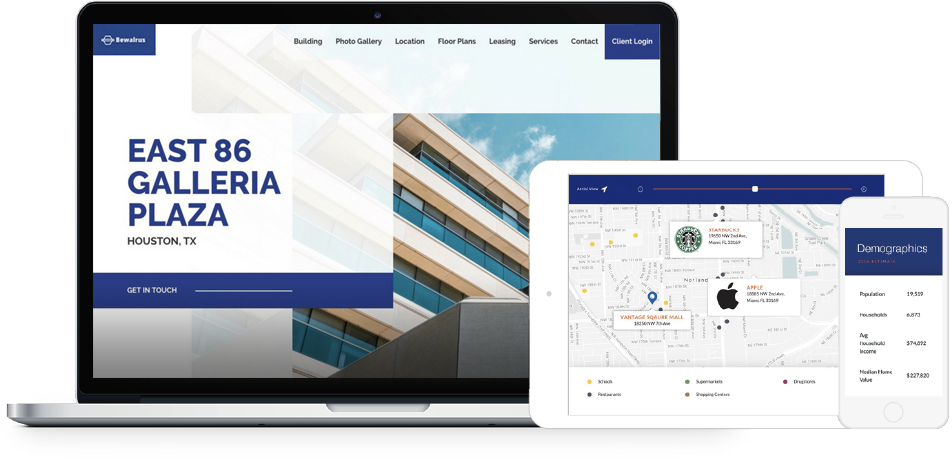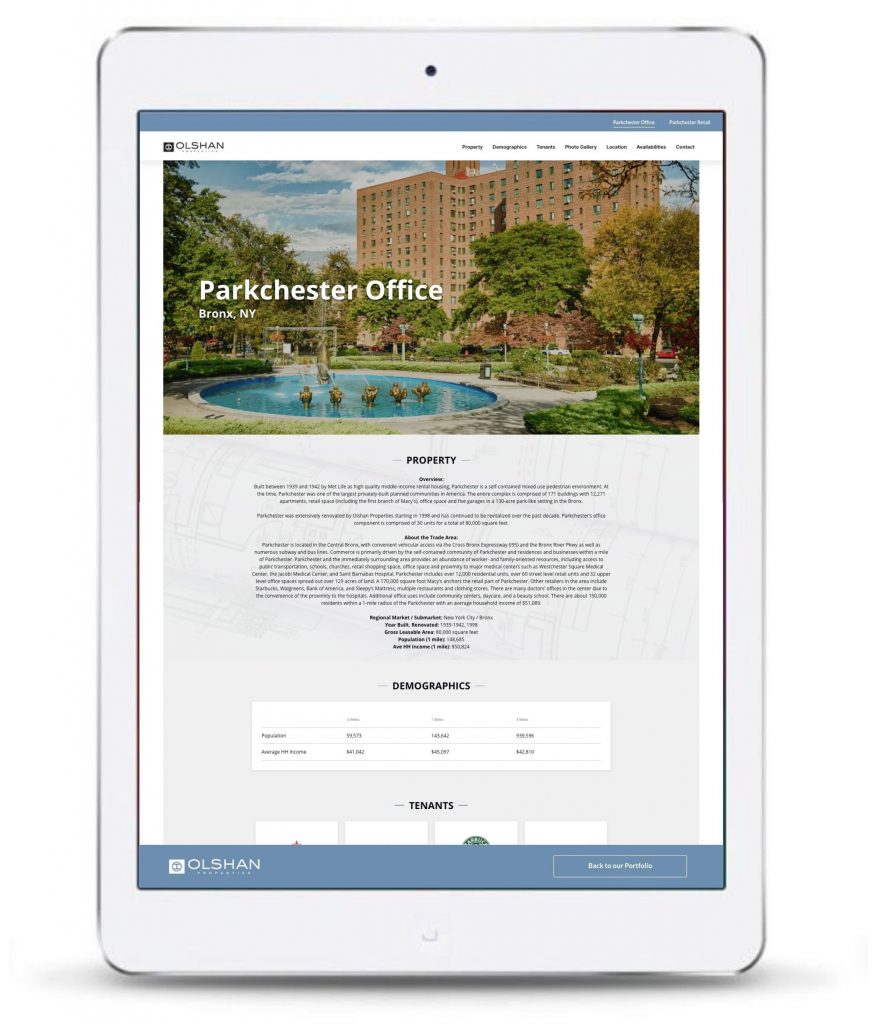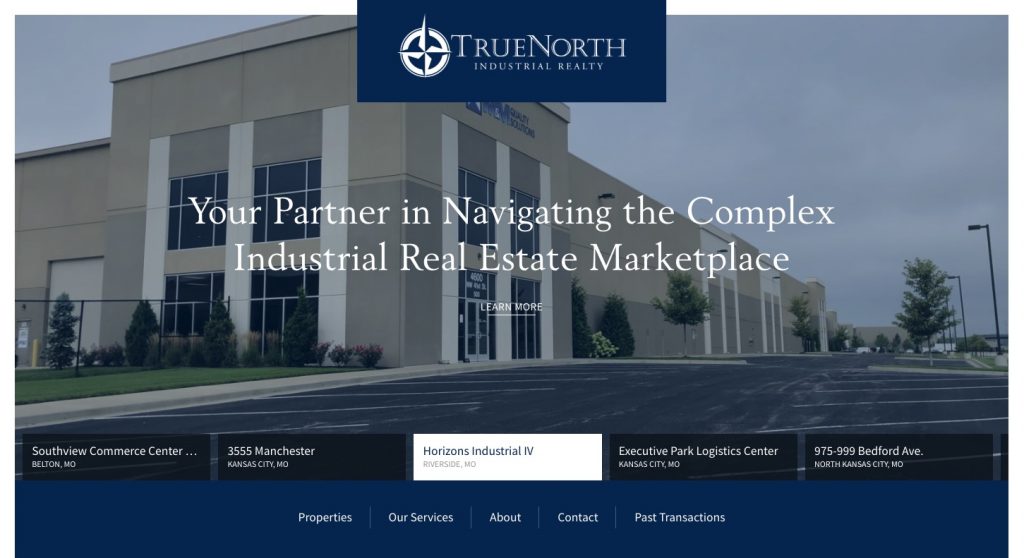
What is a Commercial Real Estate Landing page?
As a standalone page that sits in parallel to the rest of your website, a commercial real estate landing page is optimized to highlight the most important elements of a property and capture prospect information for the purposes of scheduling a call or providing key documents.
A single property landing page provides all of the most important information a prospective tenant or investor needs when they visit the site to research the property. By providing only the most important information on this real estate microsite, you can ensure your prospects obtain the information they need when they need it.
For this reason, it’s important that you have a plan in place to populate your commercial real estate website landing pages with the correct information so you can share the URL with prospects by email and social media.
With the right combination of content and conversion-oriented commercial real estate website design, you can generate more leads from your marketing efforts.
What is a Landing Page?
A landing page is the first and often only page someone sees when they click on an ad, enter a URL from print collateral, or otherwise engage with your property marketing efforts. It is designed foremost to capture and convert visitors into leads with a form, often in exchange for information or resources the lead finds enticing. A landing page is unique from other commercial marketing resources including:
Commercial Real Estate Landing Page
Specific to commercial real estate, a landing page provides key information about a property, a means by which the user can provide their information to request a phone call or download information, and follow-up information. It is a hub for all information someone might need before they make the decision to move to the next step in the buyer’s journey.

Commercial Real Estate Microsite
A microsite is designed to highlight the key elements of a specific property. Its job is to be informative, supporting both new prospects and those you have already engaged who want more information. A microsite often supplements your property listings on LoopNet or other local directories.

Commercial Real Estate Website
In addition to individual microsites, your commercial real estate website provides key information about your CRE company, and links to your other properties. It is a trust-building tool and networking resource for people looking to learn more about your portfolio and recent business dealings.

The Best Commercial Real Estate Landing Pages
The best landing pages have several things in common. They load quickly on any device type and provide a lot of information in a concise, easy to scan format. Some of the elements every good landing page should have include:
- An enticing offer and form to capture leads – Your landing page should feature a form and a downloadable offer that is enticing enough to encourage someone to complete the form. This can be downloadable floor plans, brochures or other documents, video content, or a scheduling option to see the property.
- A sleek, mobile-friendly design – More than 50% of internet activity is on a mobile device, and landing pages in particular are viewed more often while on the go. Your template must be fully responsive and ready for all sized devices.
- Interactive elements to engage users – The best landing pages give users something to do. Embed a map of the location and surrounding landmarks, virtual tours and photography of the property, or other interactive materials to engage your visitors.
- Tools in place to split test key elements – Because a landing page is only a single page, with a limited number of variables, it should be split test frequently to ensure you have the best headlines, images, feature lists, and other elements in place.
A landing page is often the only page some people will see. It needs to effectively provide enough information about the property to capture attention and move them towards a conversion, all in less than two minutes.
Single Property Landing Pages
The best landing pages are incredibly specific. They focus on a single property, often targeting a single demographic and location. There are many benefits to such a granular approach, including:
- Segmenting to Different Landing Pages – Landing pages can be segmented by purpose (lease, purchase, tenant resource), target audience (investor, buyer, tenant), or demographics (location, income level). Depending on your marketing efforts, create an outline of different landing pages you can create for individual campaigns.
- Marketing Landing Pages for Lease – A landing page specifically designed for leasing allows you to carefully craft language specific to tenants.
- Tenant Information Hub Pages – While most landing pages are designed to capture information, they can also be used to provide useful resources at key moments, minimizing the frequency with which you get questions from tenants.
- Deal Sites for Sale – With deal sites listing properties for sale, you can provide key information about properties that are currently on the market. They are very specific to individual locations and possible specific deals that you are preparing for the property.
- Property Management – For those leasing properties to tenants, a landing page is a useful tool with which to build a tenant information hub. Such hubs allow easy access to building amenities, maintenance inquiries, management contact information and more.
Landing pages make it easy to create highly customized, targeted messaging for individual audiences, properties, and situations – increasing the likelihood that they convert.
How to Create a Real Estate Landing Page
There are several options for building out real estate landing pages, including:
- WordPress – An open-source platform, WordPress features tens of thousands of unique, customized themes for different purposes. Marketplaces like ThemeForest make it easy to find and purchase these, but there are no current themes specifically designed for commercial real estate WordPress websites. It’s likely you’ll want the help of a designer/developer or marketing agency to customize a theme or build a new one with features specific to commercial real estate.
- SharpLaunch Landing Pages – SharpLaunch designs landing pages specifically for commercial real estate. The commercial real estate website templates include interactive amenities maps, floor plans and space plans as downloadable documents, demographic modules, and much more. Each module is designed to highlight key information that will be relevant to your target audience.
- Landing Page Builders – Tools like Squarespace and Wix are designed to be inherently easy to use – drag and drop tools. They offer a variety of landing page themes, but again like ThemeForest, nothing is designed specifically for commercial real estate use.
For a landing page to be effective, it needs a solid platform that allows you to quickly build and test new layouts, content, and iterations for your campaigns. Whether running paid advertising campaigns, linking from print collateral, or testing messaging from your primary website(s), it’s imperative that you find the right platform for your needs.
Ready to streamline your CRE marketing?
With SharpLaunch you can:
- Accelerate time to market 4x
- Display your property listings in real-time on your website
- Maximize visibility and stand out
Looking for the right solution for your business?
